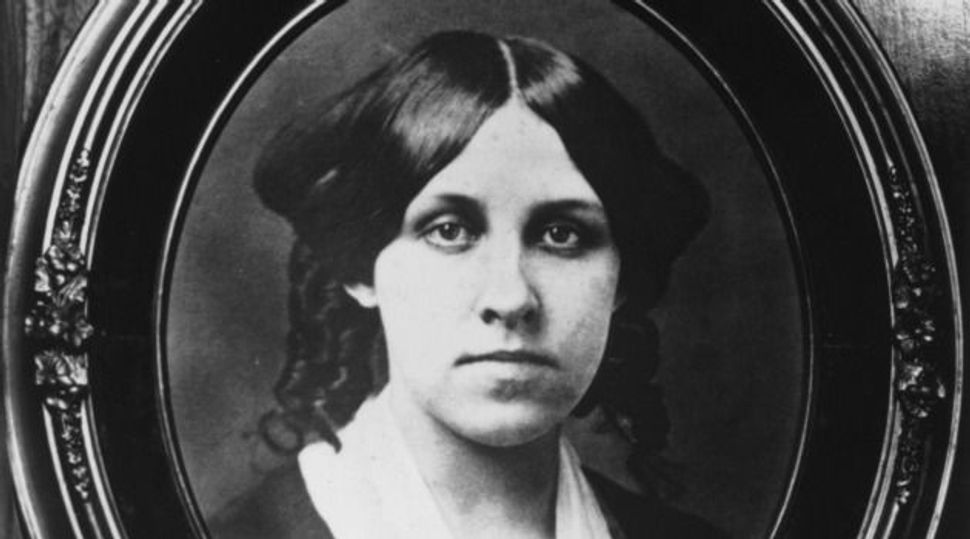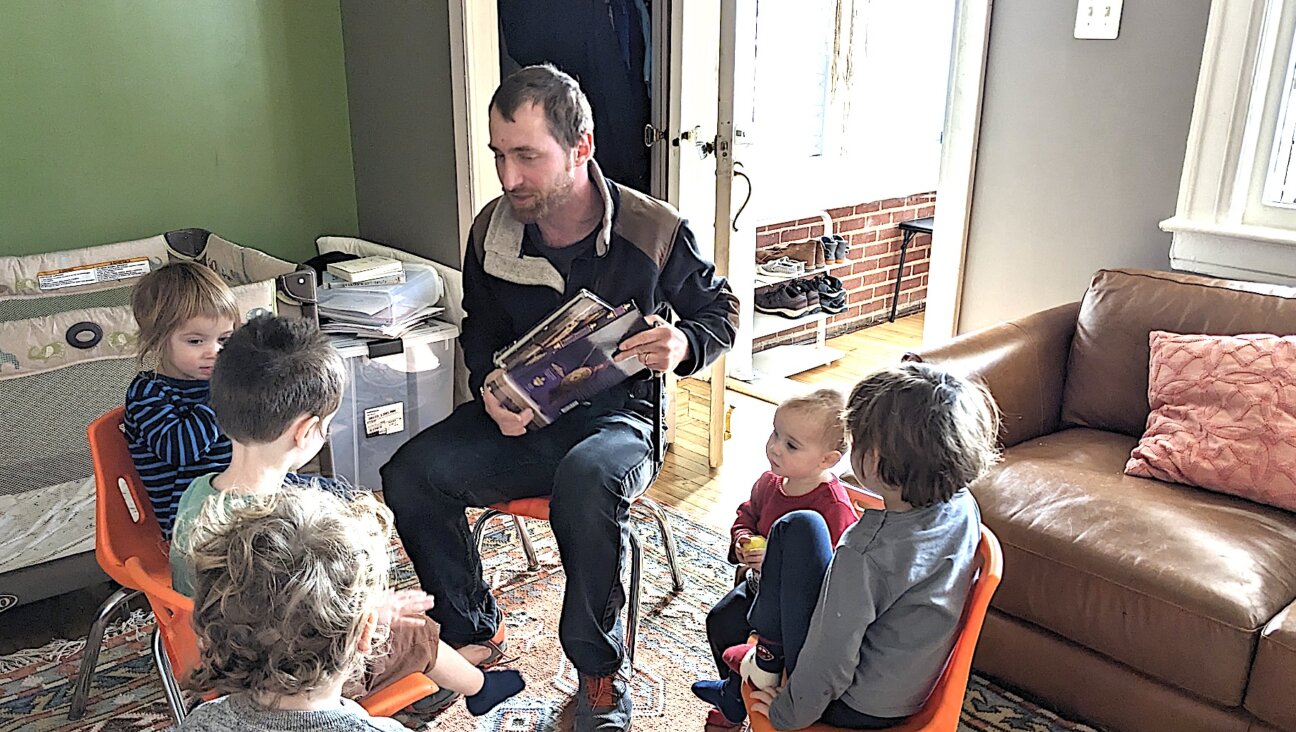Discovering Louisa May Alcott’s Jewish History on Portuguese Tour

A Little Surprising: ?Little Women? has served some Jewish immigrants to America as a tool of assimilation. But, as it turns out, the novel?s author Louisa May Alcott came from Sephardic Jewish ancestry. Image by Getty Images
Louisa May Alcott was often told as a child that her dark hair and dark eyes came from her Sephardic Jewish ancestry. Her mother, Abigail May Alcott, who had similar coloring, had learned this from her father, Joseph May, a late 18th-century Boston businessman whose Portuguese Jewish ancestors immigrated to Sussex, England, just before 1500.
The Mays spent more than a century in England, becoming prosperous enough to cross the Atlantic during the Great Migration. Around 1640, the Mays — also spelled Mayes, Maies and Maize — settled in Massachusetts, where one of their descendants was the quintessentially Yankee author of “Little Women.”
Alcott never wrote about her Jewish heritage, nor did she visit her ancestral homeland of Portugal, as I discovered while researching “Marmee & Louisa,” a dual biography of the author and her mother. As her first cousin and a great-niece of her mother, I was eager to learn more about the family’s past, so in October 2012 my family traveled to Portugal. My late aunt, Charlotte May Wilson, whose grandmother was Louisa’s closest first cousin, told me that the Jewish ancestry was a topic of pride in the family. The first person we encountered in Lisbon, the cabdriver who picked us up at the airport and took us to our hotel, offered us an impromptu history lesson on Portugal’s Jews.
“King Manuel I expelled the Jews because his second wife,” Princess Isabella of Spain, “demanded it.” The king found the Jews useful because they helped finance his government. But in 1496, under pressure from his anti-Semitic in-laws, King Ferdinand and Queen Isabella, Manuel issued a decree expelling all Jews who did not convert to Christianity. Jews who could not leave immediately were forced to convert and to assume new names, often taken from nature, such as “pear tree” (Pereira), “olive tree” (Oliveira) or a month of the year (Maio, for May).
My family was eager to see the city’s ancient Jewish quarter, so we rode the Metro downtown to the Baixa-Chiado stop. Public transportation in Lisbon by bus, subway or tram is excellent, and taxicabs are ubiquitous and inexpensive. We emerged in the oldest part of Lisbon, the Alfama, atop which Saint George’s Castle, a medieval fortification that once housed Portugal’s monarchs, affords magnificent views.
The Alfama’s winding, medieval streets are filled with cafes and shops, many decorated with flowerpots and colorful ceramic tiles.
At the foot of the Alfama, near Portugal’s oldest cathedral (Sé de Lisboa, which is mostly 13th-century) and between Rua dos Cais de Santarém and Rua de São Pedro, we found the narrow, cobbled street we were looking for, Rua da Judiaria. Until about 1500, this Street of the Jews was the center of Portugal’s Jewish community, just below and outside the wall surrounding Saint George’s Castle.
As we rounded the corner and studied the street sign, an old woman behind a barred window peered down at us, expressionless. We were not the first visitors here. We meandered through the tangle of buildings that was once home to Lisbon’s Jews, passing a beautiful fountain and part of the wall of a synagogue.
Here, on the site of a 15th-century synagogue, King Manuel I had built in the early 16th century what is now one of Portugal’s oldest places of worship, Igreja da Conceicao Velha — the Old Church of the Immaculate Conception. The church was a gift for his sister, Leonor of Viseu, founder of the Order of Mercy. The great earthquake of 1755 destroyed most of the building, except the facade. One of the carved figures on the ornate front door is King Manuel I himself.
Jewish history in Portugal goes back to the Roman Empire. From the eighth to the 12th century, as Christians and Muslims battled for regional control, Jews — many of whom knew Arabic — served Christians as diplomats and intermediaries. After the Christian “reconquest” of Portugal, around 1150, Jews enjoyed prominent positions as merchants, scientists, artists and financiers, often protected by the king, who called them “Judei mei,” “my” Jews.
By the 15th century, the kingdom had more than 100 judiarias, or Jewish quarters, each with its own synagogue. Portugal’s Jewish community thrived, relatively free of persecution.
Tensions grew in the 15th century. Jews were forced to wear an identifying emblem and to obey a curfew, and they could no longer employ Christians.
By 1500, under Manuel I and his Spanish wife, many thousands of Jews, including some of Alcott’s ancestors, had left or had been expelled. The converted Jews who remained in Portugal — known as New Christians or by such derogatory terms as Crypto-Jews, marranos and conversos — suffered persecution.
In April 1506, in Lisbon, a mob rounded up hundreds of New Christians and some Old Christians suspected of helping them secretly practice Judaism. The mob burned down dwellings in the Judiaria and massacred more than 2,000 Jews in a public square. King Manuel I executed the leaders of the mob and, in an effort at compensation, granted New Christians religious freedom for 20 years.
Rossio Square, the site of the massacre, just west of the Alfama in central Lisbon, is a huge, handsome open space paved with Portuguese mosaic, dotted with fountains and surrounded by shops and cafes. The inscription on a memorial stone placed here on the 500th anniversary of the massacre, in 2006, reads, in translation, “In memory of the thousands of Jews who were the victims of intolerance and religious fanaticism and murdered in the massacre initiated on April 19, 1506, in this square.”
The Baroque Church of Sao Domingos, at the northeast corner of Rossio Square, was built on the site of the Tribunal of the Inquisition. The tribunal met in Lisbon from the 1540s until the 18th century. Its actions led to public burnings — autos da fé — of heretical Christians and more than 1,000 New Christians suspected of heresy or of secretly maintaining their Jewish faith. Inquisitorial tribunals exist- ed in Lisbon, Coimbra, Porto and Évora.
We took a fast train to Coimbra, a hill town on the Mondego River in central Portugal, to see another region of importance. Coimbra — the name comes from a Celtic word for “high, rocky place” — was the capital of Portugal until the 14th century. Before 1500 it was a major center of Jewish population.
A bus delivered us from the train depot to the town’s central square — actually a triangle surrounding a statue — where our tour began. Our first stop was the 16th-century church of the Monastery of Santa Cruz, a fine example of the Manueline style of architecture, a combination of Gothic and Renaissance features named for the king.
Santa Cruz is decorated with carved symbols of Portugal’s powerful empire during Manuel’s reign. Ropes signify Portuguese ships, which sailed to the ends of the world, while pomegranates, peppers and spices signify the fruits of those explorations. In the 16th century, during the Inquisition, autos da fé took place in the square in front of this church.
A nearby alley called Rua Corpo de Deus (Corpus Christi St.) marks the entrance to the historic Jewish quarter. We climbed through the Judiaria Velha, Coimbra’s first and oldest Jewish quarter, established in the 12th century, and the newer, 14th-century Jewish quarter. A 1725 fountain on Rua Olímpio Nicolau Fernandes is called the Fonte Nova, also known as the Jewish Fountain.
At the top of the hill, past the city’s magnificent Romanesque Old Cathedral, is the University of Coimbra, one of Europe’s oldest universities, founded in 1290. This is a university town: One in five residents of Coimbra is a student.
Created out of a palace occupied by the early kings of Portugal, the university boasts the second-largest library in Portugal. Its gorgeous Biblioteca Joanina, erected in the early 18th century, contains important papers of local Jewish scholars, many of whom were students or professors here. The ramparts afford views of Coimbra’s city’s red-tile roofs, the river below and the surrounding countryside.
Our final destination, a short walk northwest of the university, was the Pátio da Inquisição — Courtyard of the Inquisition — where Coimbra’s inquisitorial trials were held. Coimbra’s tribunal disposed of more than 11,000 individual cases between the 16th and 18th centuries.
Some of the trials lasted for years, while the accused waited in prison. Records indicate that more women than men were tried, convicted and executed, probably because mothers and grandmothers were held responsible for maintaining Jewish beliefs and practices among New Christians. As recently as 1718, in this courtyard, the tribunal tried more than 60 suspected Jews and then burned two people at the stake. On this spot, students and tourists now gather at the Restaurante O Pátio cafe.
By prior arrangement of our local guide, the informative Tiago Boavida, we were able to view torture chambers where the accused were held as they awaited trial. The chambers are in the basement of a 16th-century building that is now part of the university’s art school, the Centro de Artes Visuais. A student unlocked the door, welcomed us inside the cavernous space now used as an art gallery and removed a panel of floorboard. Metal stairs led down into the empty, whitewashed cells.
Afterward, as I stood outside in the school’s peaceful courtyard, surrounded by flowering plants and 16th-century capitals, it occurred to me that these cells are where Alcott’s ancestors might have been held if they had stayed in Portugal. In that case, their American descendants — and the writings of Alcott — would not exist.
In a strange twist, “Little Women” has served some Jewish immigrants to America as a tool of assimilation. “No book I have opened has meant as much to me,” a Russian Jewish immigrant, Elizabeth G. Stern, observed in 1917. “That small volume [told], in simple words such as I myself spoke, the story of an American childhood in New England.”
Portugal has attempted in recent years to redress some wrongs done to Jews. During World War II, Portugal’s consul general in Bordeaux, Aristides de Sousa Mendes, created an escape route through Lisbon that allowed an estimated 1 million refugees to escape the Nazis — many more than the renowned Oskar Schindler saved. Sousa Mendes accomplished “the greatest single act of rescue by an individual during the war,” according to Holocaust historian Yehuda Bauer.
In 1966, Israel honored Sousa Mendes, who had died more than a decade before, as Righteous Among the Nations. He posthumously received Portugal’s Order of Liberty medal, and the Sousa Mendes Foundation is dedicated to his memory. His ancestral mansion, Caso do Passal, in Portugal’s northern town of Cabanas de Viriato, is being renovated as a memorial museum. In 1987, President Mário Soares apologized to the Jewish community for Portugal’s Inquisition and other persecutions.
Today, only a few thousand Jews live in Portugal. But Jewish ancestry is not as uncommon as it might seem. Nearly one in five Portuguese citizens, according to a recent study in The American Journal of Human Genetics, has Jewish ancestry. Apparently, the number of Portuguese Jews forced to convert to Christianity half a millennium ago was far larger than historians previously believed. As for the countless Jews who fled Portugal, their descendants include the economist David Ricardo and the philosopher Baruch Spinoza, as well as Louisa May Alcott.
Eve LaPlante is the author, most recently, of “Marmee & Louisa: The Untold Story of Louisa May Alcott and Her Mother,” and the editor of “My Heart Is Boundless: Writings of Abigail May Alcott, Louisa’s Mother” both published by Free Press in 2012.















